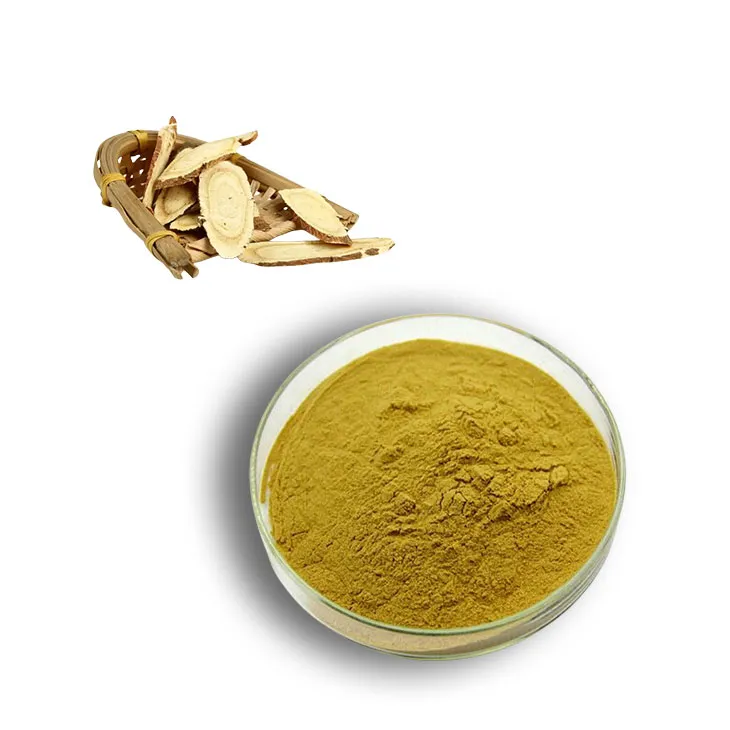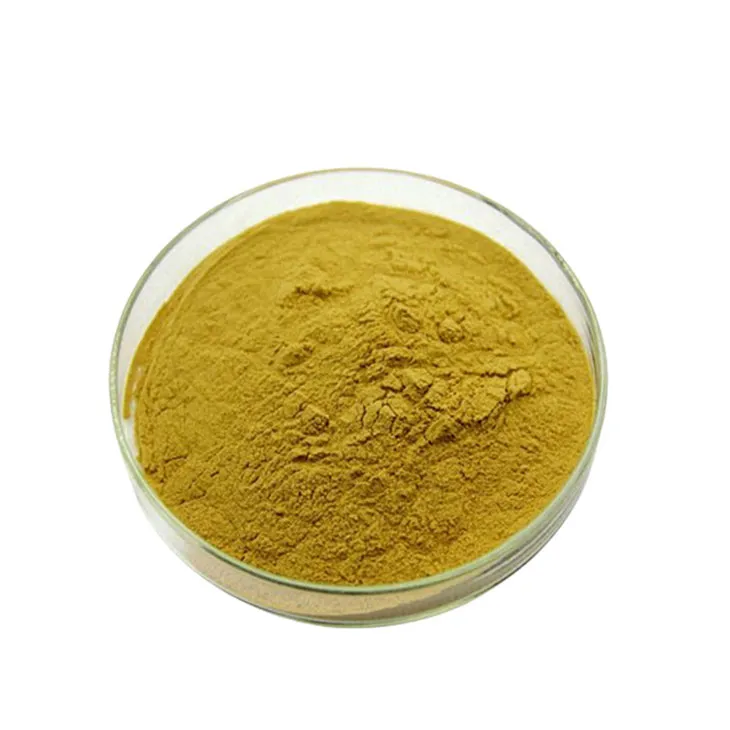- 0086-571-85302990
- sales@greenskybio.com
Licorice Root Extract Powder: Their Production Methods and Reasons for Their Popularity.
2024-12-12

1. Introduction
Glycyrrhiza glabra, widely known as licorice, has a long - standing history in traditional medicine that spans across centuries. In recent times, Licorice Root Extract Powder has been steadily rising in popularity. This article aims to comprehensively explore the production methods of Licorice Root Extract Powder and the reasons behind its growing popularity.

2. Production Methods of Licorice Root Extract Powder
2.1 Harvesting
The first step in the production of licorice root extract powder is harvesting the licorice roots. Licorice plants are typically grown in well - drained soil in areas with a suitable climate. The roots are usually harvested when the plants have reached a certain level of maturity. This is a crucial step as the quality of the roots at the time of harvest can significantly impact the final quality of the extract powder. Farmers need to be careful during the harvesting process to avoid damaging the roots, as any damage can lead to a reduction in the active compounds present in the roots.
2.2 Cleaning
Once the roots are harvested, they need to be thoroughly cleaned. This involves removing any dirt, debris, and other impurities that may be attached to the roots. Cleaning can be done using a combination of mechanical and manual methods. For example, the roots may be first washed with water to remove the loose dirt, and then carefully inspected and any remaining impurities manually removed. This step is essential to ensure that the final extract powder is pure and free from contaminants.
2.3 Drying
After cleaning, the licorice roots are dried. Drying can be carried out in different ways, such as natural drying in the sun or using mechanical drying equipment. Natural drying is a traditional method that is still used in some areas. However, it has some limitations, such as being dependent on weather conditions and taking a relatively long time. Mechanical drying, on the other hand, can be more controlled and usually takes less time. The roots are dried until they reach a suitable moisture content, which is important for the subsequent extraction process.
2.4 Grinding
Once the roots are dried, they are ground into a fine powder. This is usually done using grinding machines. The grinding process needs to be carefully controlled to ensure that the powder has a consistent particle size. A fine powder is preferred as it provides a larger surface area for the extraction process, which can lead to a more efficient extraction of the active compounds from the licorice roots.
2.5 Extraction
The ground licorice root powder is then subjected to the extraction process. There are different extraction methods that can be used, including solvent extraction. In solvent extraction, a suitable solvent, such as ethanol or water, is used to extract the active compounds from the powder. The solvent and the powder are mixed together in a controlled environment, and the mixture is stirred for a certain period of time to allow the active compounds to dissolve into the solvent. After that, the solvent containing the dissolved compounds is separated from the remaining solid material.
2.6 Purification
The extract obtained from the extraction process may contain impurities. Therefore, it needs to be purified. Purification can be achieved through various techniques, such as filtration and chromatography. Filtration can be used to remove larger particles and insoluble impurities. Chromatography, on the other hand, can be used to separate and purify the different active compounds present in the extract. This step is crucial to ensure that the final licorice root extract powder has a high purity and quality.
2.7 Drying and Packaging
After purification, the extract is dried again to remove any remaining solvent. Once dried, the licorice root extract powder is ready for packaging. The powder is usually packaged in air - tight containers to protect it from moisture, air, and other environmental factors that could affect its quality. Proper packaging also helps to extend the shelf - life of the product.

3. Reasons for the Popularity of Licorice Root Extract Powder
3.1 Health Benefits
One of the main reasons for the popularity of licorice root extract powder is its potential health benefits. Licorice contains a variety of active compounds, such as glycyrrhizin, which has been shown to have anti - inflammatory properties. Inflammation is associated with a wide range of health problems, including chronic diseases such as arthritis, heart disease, and diabetes. By reducing inflammation, licorice root extract powder may potentially help in the prevention and management of these diseases.
Furthermore, licorice has also been reported to have antioxidant properties. Antioxidants play an important role in protecting the body against oxidative stress, which is caused by free radicals. Free radicals can damage cells and DNA, and are implicated in the development of various diseases and the aging process. The antioxidant properties of licorice root extract powder may help to neutralize free radicals and protect the body's cells.
Another potential health benefit of licorice root extract powder is its effect on the digestive system. It has been traditionally used to soothe the digestive tract and relieve symptoms such as indigestion, heartburn, and stomach ulcers. Some studies suggest that licorice may help to increase the production of mucus in the stomach, which can protect the stomach lining from the corrosive effects of stomach acid.
3.2 Use in the Cosmetic Industry
Licorice root extract powder is also popular in the cosmetic industry. It has skin - enhancing qualities that make it a valuable ingredient in many cosmetic products. For example, its anti - inflammatory properties can be beneficial for treating skin conditions such as eczema, psoriasis, and acne. These skin conditions are often associated with inflammation, and the use of licorice root extract powder may help to reduce redness, swelling, and itching.
In addition, licorice root extract powder has been found to have skin - whitening properties. It can inhibit the activity of an enzyme called tyrosinase, which is involved in the production of melanin, the pigment responsible for skin color. By inhibiting tyrosinase, licorice root extract powder may help to lighten the skin tone and reduce the appearance of dark spots and hyperpigmentation.
Many cosmetic products, such as creams, lotions, and serums, now contain licorice root extract powder as an ingredient. It is also used in some natural and organic cosmetic formulations, as it is considered a relatively safe and natural alternative to some synthetic ingredients.
3.3 Use in the Food Industry
The use of licorice root extract powder in the food industry is another factor contributing to its popularity. Licorice has a distinct and pleasant flavor that can be used for flavoring a variety of foods and beverages. It is often used in confectionery products, such as candies and chewing gums, to give them a characteristic licorice flavor.
Moreover, licorice root extract powder can also act as a natural sweetener. It contains glycyrrhizin, which is much sweeter than sucrose. In some cases, it can be used as a substitute for artificial sweeteners in food products, providing a natural and potentially healthier alternative.

4. Conclusion
In conclusion, licorice root extract powder has a complex production process that involves multiple steps from harvesting to packaging. The popularity of this powder can be attributed to its potential health benefits, its use in the cosmetic industry for skin - enhancing qualities, and its application in the food industry for flavoring and as a natural sweetener. As research continues to explore the properties and potential applications of licorice root extract powder, it is likely to remain a popular and valuable ingredient in various industries.

FAQ:
What are the main steps in the production of licorice root extract powder?
The production process of licorice root extract powder involves several main steps. First, the licorice roots are harvested. Then, they are usually washed to remove dirt and impurities. After that, extraction methods such as solvent extraction may be used to obtain the active components from the roots. This is followed by purification steps to ensure the quality and concentration of the extract. Finally, the extract is dried and powdered to get the licorice root extract powder.
What are the anti - inflammatory properties of licorice root extract powder?
Licorice root extract powder contains certain compounds, such as glycyrrhizin, which are thought to contribute to its anti - inflammatory properties. These compounds may interact with the body's immune system and inflammatory pathways. For example, they might help regulate the production of cytokines, which are involved in the inflammatory response. However, more research is still needed to fully understand the exact mechanisms and how these properties can be harnessed for medical applications.
How is licorice root extract powder used in the cosmetic industry?
In the cosmetic industry, licorice root extract powder is used in various ways. It can be added to skincare products like creams, lotions, and serums. Due to its potential skin - enhancing qualities, it may help in reducing skin inflammation, improving skin tone, and giving a brighter complexion. It may also have antioxidant properties that can protect the skin from damage caused by free radicals, which is beneficial for maintaining healthy - looking skin.
What role does licorice root extract powder play in the food industry?
Licorice root extract powder is used in the food industry mainly for flavoring. It imparts a unique sweet and slightly bitter taste to food products. It can be found in some candies, beverages, and baked goods. In addition to flavor, in some cases, it may also contribute to the preservation of food due to its natural properties.
Are there any potential side effects of using licorice root extract powder?
Yes, there can be potential side effects. High or long - term use of licorice root extract powder may cause issues such as increased blood pressure, fluid retention, and potassium loss in some individuals. This is mainly due to the glycyrrhizin content in licorice. People with certain health conditions like hypertension or kidney problems should be especially cautious when using products containing licorice root extract powder.
Related literature
- The Production and Applications of Licorice Root Extract: A Comprehensive Review"
- "Licorice Root Extract Powder: Health Benefits and Industrial Uses"
- "Anti - Inflammatory Properties of Licorice Root Extract in Modern Medicine"
- ▶ Hesperidin
- ▶ Citrus Bioflavonoids
- ▶ Plant Extract
- ▶ lycopene
- ▶ Diosmin
- ▶ Grape seed extract
- ▶ Sea buckthorn Juice Powder
- ▶ Fruit Juice Powder
- ▶ Hops Extract
- ▶ Artichoke Extract
- ▶ Mushroom extract
- ▶ Astaxanthin
- ▶ Green Tea Extract
- ▶ Curcumin
- ▶ Horse Chestnut Extract
- ▶ Other Product
- ▶ Boswellia Serrata Extract
- ▶ Resveratrol
- ▶ Marigold Extract
- ▶ Grape Leaf Extract
- ▶ New Product
- ▶ Aminolevulinic acid
- ▶ Cranberry Extract
- ▶ Red Yeast Rice
- ▶ Red Wine Extract
-
Oyster Mushroom Extract Powder
2024-12-12
-
Yohimbine Bark Extract
2024-12-12
-
Baicalin
2024-12-12
-
Green coffee bean Extract
2024-12-12
-
Hawthorn powder
2024-12-12
-
Diosmin
2024-12-12
-
Eucommia Ulmoides Extract
2024-12-12
-
Yam Extract
2024-12-12
-
Lily extract
2024-12-12
-
Yellow Pine Extract
2024-12-12





















